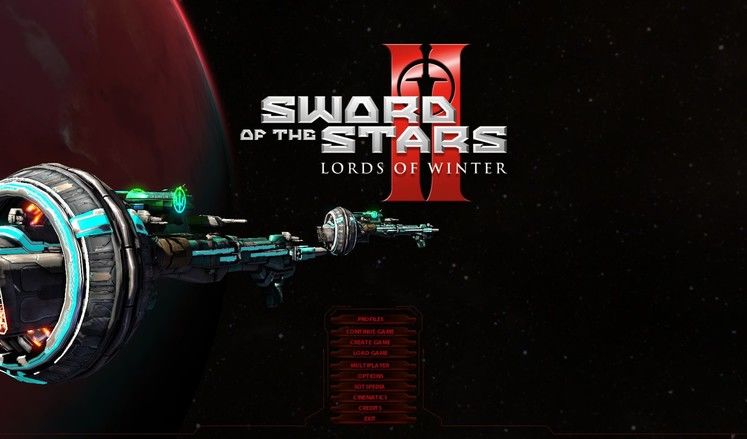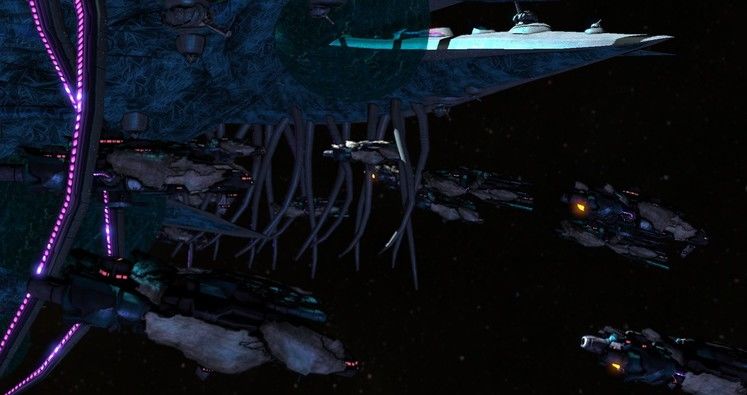 |
| Credit where credit's due - the level of detail on ships is amazing... |
But there is a slight flaw with it that isn't to do with the game being buggy, rather a fundamental design choice that was also another 'major' change. Going with the 'Less is More' principle this time around, Kerberos decreased the maximum number of systems in any given map, but increased the amount of planets and objects within those systems, making them more true to reality. As such, battles take place in an entire system now, with the sun, planetary bodies, asteroid fields and whatever else is present all being there at once. The problem is that the ships move too slowly in order to traverse the whole space in one 'round', even if you set things so that you have the full 12 minutes available.
It's not so much of an issue for the smaller engagements, like for instance at the start of a game, but for larger battles, system with a lot in them, or certain random encounters that spawn mobs around each planet within a system, the new set-up basically means you're set to fighting one round per turn until either you or them are wiped out. On balance, (considering you can't pause real-time engagements), this stops you from getting drawn into anything too time-consuming, but it also kind of defeats the point of having a whole system to play with in the first place. But there is an extra strategic layer in place in the form of sectors that you can control. In-between rounds you can access the Defence Manager (which we think is being renamed the Battle Manager because it works both in offensive and defensive actions) to place your ships in sectors under your control. We guess the point of the strung out engagements is to slowly take ground form the enemy, and out-manoeuvre your opponents using the sectors.
This just brings us to another problem that the game has however, which is the lack of tool-tips and information to highlight these things. With the state that the code is in as well, the situation is merely exacerbated because it's hard to tell whether features are missing, or there's just something you need to figure out in order to get them to work. For example, the 'Trade' layer, which is similar to the trade sectors of the previous game, wasn't present until a couple of patches ago - however, there's still no obvious indication as to how they actually work, and how you service them (digging into the encyclopaedia and looking online helps, but it really shouldn't need to come to that).
 |
| Of course, as a testament to how sluggish the game is right now, even the main menu takes a while to load... |
Early match will see you mainly searching, expanding and researching tech. Ships are now organised into more formal 'fleets' now, which have to have a command ship and an admiral (in the last game you could just group ships together as and how you pleased, and a command ship wasn't mandatory, but recommended). Fleets also have to be based at a Naval Base (one of many orbital structures you can build), and have a maximum area of operations based on Supply and the support range of the home base. Instead of just sending a fleet somewhere and performing contextual actions, you have to assign missions, which restricts flexibility of fleets. Unless they are based in a system, they can't simply sit there, so you would have to send a fleet on a 'Patrol' mission if you're worried about invasion. Similarly, things like Colonisation, Attacks and Invasions... they are all missions that can be assigned.
In terms of the more management aspects, there's more feedback and interaction in terms of budgets, and how much money is spent where and what for. Sliders galore! Groups of planets can also be grouped into provinces, which we heard about at preview stage although their actual impact has yet to be determined, and as far as research goes it's much the same as the last game, except technology has moved on, and you now have to conduct 'Feasibility Studies' for any techs that are available to you, but not something your empire would be naturally pre-disposed to researching. There has also been a change to the design portion of the game, whereby you can now enter a limited version of the RTS-screen and conduct 'weapons tests', and the first of each new design is considered a prototype. At the moment though, there could be more feedback as to what everything actually does and what the pros and cons are, and the prototypes are almost prohibitively expensive.
Perhaps calling the game 'dire' is a bit harsh, perhaps not - as we've said, it IS playable. It's also sluggish, half-finished, it still crashes from time to time, and overall, it's just kind of uninspiring right now. CEO and front man Martin Cirulis himself said the game was just a pile of "shot up code". No matter how humble or apologetic they are, we suspect they knew full well what the game was going to turn out like, and decided not to tell anyone. Or they didn't, which in a way is even worse. Paradox knew as well, but after physically talking to some of them, you get the impression those guys are trying to take the bullets, or jump on the grenade.
 |
| Each races distinctive visual style really come through as well... |
History tells us that, eventually, Sword of the Stars II is going to be great - possibly even amazing. Play the original game now and you'll find it a wonderful sci-fi strategy romp... although legend tells us that it's own release wasn't fantastic either. At the moment, SOTS2 is playable, but not really enjoyable - some tech-trees aren't fully implemented, features are incomplete or turned off (we don't anything is out-right missing but... at the moment, it's really hard to tell) and it's just a little bit boring right now. If you want to show Paradox and Kerberos your support, then by all means go buy it, but regardless of whether you pick it up now or not, it'll probably take a couple of months of patches to be the game it was meant to be.
TOP GAME MOMENT
The new engine makes space battles all the more engaging, and when all of the features are working properly, they will easily be the best bit of the game.




